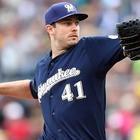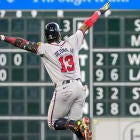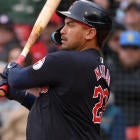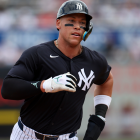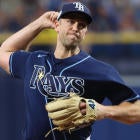Note: FanDuel is hosting a one-day Fantasy Baseball league tonight. It's $5 to enter and pays out $100,000 in cash prizes. First place wins $10,000. Sign up now!
The 2015 season might not be over yet, but already, I'm making resolutions for 2016.
For years, I have prided myself on being the sort of Fantasy owner who doesn't chase after every trendy player, putting my trust in large samples and long-term trends. Now that I have been knocked out of contention in more leagues than I'd like to admit, I've had some time to reconsider my approach and think differently about the year ahead.
At least when it comes to Fantasy baseball, I have been largely immune to the phenomenon known as FOMO -- the Fear of Missing Out. If I wasn't the first on my block to pick up the latest big-name callup or formerly obscure player suddenly in the midst of a hot streak, I rarely felt like I was missing out. Unless the player in question was already on my radar as a breakout candidate, I could resist the temptation to use my waiver priority or dip into my FAAB account to go after him.
When I look back at my season, and particularly the disappointments, I clearly could have used some FOMO. Instead, I was more driven by TOFU, which is the Terror of Forfeiting Upside. (I initially coined this as something more general and less G-rated.) I was so afraid of betraying my faith in the players I drafted or targeted early in the season that I missed out on undrafted gems like Jung-Ho Kang, Matt Duffy and Raisel Iglesias.
I did have at least one FOMO moment that worked out when I went hard after Lance McCullers on the basis of 29 utterly dominant innings in Double-A. I needed to be doing more of this.
Instead, I took the wrong lesson from a move gone haywire in a 12-team NL-only league. In late May, I dropped a struggling Triple-A pitcher, who had a 6.90 ERA with no clear path to the majors. I needed the roster space to pick up Kendry Flores, who was rumored to be among several candidates to fill a vacancy in the Marlins' rotation. Flores has made just one start for the Marlins this season. The pitcher I dropped was Taylor Jungmann, who was claimed two weeks later for $1. Needless to say, I could have used Jungmann's nine wins and 3.05 ERA.
The lesson that I should have learned from this debacle is that a player doesn't need years or even months to make a impactful change in his game. In an interview shortly after his callup, Jungmann explained how a change in his location on the pitching rubber and a reliance on his four-seamer enabled him to pitch with better control and stronger ground ball tendencies. The impact of those changes were evident in Jungmann's results, particularly over his first 11 starts.
Just as I needed to take the changes in Jungmann's processs and results seriously, his owners needed to pay attention to the decline that began for him about a month ago. He started to deemphasize his four-seamer, and it was less effective when he did use it. Jungmann's rise and fall shows that it doesn't pay to stay stuck in preconceived notions of a player's value.
In short, assessing players and Fantasy rosters requires constant course correction.
In clinging to TOFU rather than FOMO, I remained fixed in my assessment of many of the players I drafted. In turn, I missed out on opportunities to upgrade my rosters.
An extreme example of my attachment to upside was in the 15-team mixed Tout Wars Rotisserie league. Remember when Reds manager Bryan Price kept Devin Mesoraco in limbo, restricting him almost exclusively to pinch hitting over a month-and-a-half period before the team finally placed him on the DL? I stubbornly kept Mesoraco in my lineup for the first month of that stretch. In retrospect, it was a monumentally wasteful move, especially after the first two weeks. The fact that I was at or near the top of the standings during that period gave me the false impression that I had a margin of error that would allow me to accept the possibility of near-zero production from Mesoraco.
Even as I sank in the standings, I continued to give away standings points at first base by starting Adam LaRoche. Granted, it's hard to find upgrades in a deep league, even at first base, but little would have been lost by subbing in hot hands and short-term fill-ins. For example, if I had started Clint Robinson in place of LaRoche all season long, I would have gained two standings points in OBP without losing ground in any other category, even though Robinson has started only sporadically. I could have potentially gained even more standings points with timely and aggressive substitutions.
Did LaRoche have the potential to approach last season's .362 OBP? Of course. But as the availability of Robinson and his .372 OPB on waivers all season has shown, it wouldn't have been that hard to find someone else to provide it while I was waiting for LaRoche to show signs of coming around.
I would not have had the same attachment to LaRoche in a 12-team mixed league, but even in a deeper format with OBP instead of Avg, he went for $16. In this format, LaRoche at his best was far from replacement-level, but he also wasn't a $25 or $30 player who would be a part of my team's core.
While LaRoche's upside was limited, it's easier to see why I would have TOFU with Jose Reyes. He was my starting shortstop all season in our Podcast Listeners League, and I expended a fourth-round pick to get him, which is typical of where he was getting drafted in 12-team mixed leagues. Still, Reyes ranks just 12th in value among shortstops in this format, and he has not produced appreciably more on a per-plate appearance basis than Eugenio Suarez and Asdrubal Cabrera, who could have been picked up on waivers. Both would have been far more productive options in the second half, so being stubborn even with a true high-ceiling player like Reyes turned out to be costly.
My point isn't to catalog all of my bad decisions from this season or even to make a case that Fantasy owners should follow their FOMO all the way to a title. There was an argument for giving Mesoraco, LaRoche and Reyes a chance to deliver the value I expected from them, but in each case, I waited too long to bench them. Just because a player is well above replacement level on Draft Day doesn't mean that they remain that way deep into the season. Not only can a player fail to play up to his potential, but the pool of players at a given position can change in quality as the season progresses.
Once Mesoraco had been held out of the starting lineup for nearly all of April, it was time to look for an alternative, such as early callup Blake Swihart or Yan Gomes' fill-in, Roberto Perez. When LaRoche was fading badly in the weeks leading up to the All-Star break, a cheap bid on Robinson wouldn't have hurt. When I had opportunities to fill other needs by trading Reyes, I should have taken them and picked up the likes of Suarez off waivers.
What I can take away from this season is that FOMO isn't always a bad impulse, and that too much TOFU can be a bad thing. Was my FOMO on Flores justified, even if I hadn't missed out on keeping Jungmann? Probably not. High whiff and popup rates in six Double-A starts, along with a rumored callup, might be enough to merit an add, but only if it literally cost me nothing. While it looked like Jungmann's season was going nowhere, it was clearly within the realm of possibility to not only get a callup, but for him to turn his season around. Using questionable judgment on Flores, however, didn't mean that it would have been a mistake to pursue Kang, Duffy and Iglesias with more gusto.
Even going aggressively after Swihart would have been a good idea, even if it wouldn't have come close to saving my season. It would have been a case of good process leading to a sub-optimal result.
Just as the cost-benefit calculus has to make sense when giving in to FOMO, the same is true when deciding to ignore one's TOFU. There's a fine line between recklessly discarding untapped upside and stubbornly clinging to outdated expectations. Every time I considered trading Reyes, I thought about the risk of giving up on elite production. He had, in fact, finished as the leader among shortstops in Fantasy points in two of the last three seasons. However, the depth and quality of the shortstop position had fallen off greatly in 2013 and 2014. It's a different landscape now than when Reyes, Troy Tulowitzki, Ben Zobrist and (sometimes) Hanley Ramirez would routinely get some distance from the pack. By ignoring this, I greatly exaggerated the risk of letting Reyes go.
There is no clear point at which one crosses over from calculated risk-taking to recklessness or from caution to paralysis. The only antidote to sloppy or stagnant roster management is for Fantasy owners to be assessing their players and the market on a frequent, consistent basis. That means paying attention to short- and long-term performance trends and the changing shape of the position-by-position landscape. It's one big balancing act and it requires a lot of attention.
While being vigilant and making constant course corrections along the way involves a high level of effort, I have seen it pay off time and time again. When I think of the owners I have played against who have won consistently -- and Fred Zinkie and my colleague, Scott White, come to mind immediately -- this is the process that is the common link. It's also a part of what Larry Schechter wrote about in his book, Winning Fantasy Baseball, and Larry's lengthy run of success in Tout Wars speaks for itself.
There isn't much time left this season, and in most of my leagues, getting a title is out of reach. It's not too soon, though, to start practicing a better process. And belatedly replacing Adam LaRoche with Clint Robinson is just the beginning.













